#Tortoise Facts
Explore tagged Tumblr posts
Text
youtube
Discovering the Red-Footed Tortoise
Meet the red-footed tortoise, a social herbivore with a colorful shell! Learn about its unique behavior and vital role in the ecosystem.
Check out my other videos here: Animal Kingdom Animal Facts Animal Education
#Helpful Tips#Wild Wow Facts#Red-Footed Tortoise#Tortoise Facts#Red-Footed Tortoise Care#Pet Tortoise#Animal Education#Tortoise Habitat#Wildlife Tips#Animal Kingdom#Reptile Care#Animal Facts#Nature Education#Reptile Facts#Exotic Pets#Tortoise Diet#Endangered Species#Animal Welfare#Conservation Tips#Animal Behavior#Pet Reptiles#Reptile Health#Animal Enthusiasts#Wildlife Conservation#Educational Resources#Animal Science#Interesting Animal Facts#youtube#animal habitats#fun animal facts
0 notes
Text

It’s a stupendous Fossil Friday! Let’s celebrate with Stupendemys geographicus, the “stupendous turtle.” This reptile lived during the Late Miocene some 5 million years ago, and it’s one of the largest turtles to have ever existed. Scientists think this giant’s carapace could grow up to 7.9 ft (2.4 m) long and that it could weigh up to 2,524 lbs (1,145 kg). Stupendemys geographicus is a pleurodire, or side-necked turtle, closely related to the living Podocnemis genus. No skull of Stupendemys has ever been found. The sculpted skull used in this exhibit is based on that of another very large pleurodire thought to be related to Stupendemys. See it up close in the Hall of Vertebrate Origins! Plan your visit.
Photo: © AMNH
#science#amnh#museum#fossil#nature#natural history#animals#fact of the day#paleontology#did you know#turtles#tortoise#herpetology#natural history museum#museum of natural history#american museum of natural history#cool animals#miocene#fossil friday
1K notes
·
View notes
Text

A new challenger approaches (slowly)
[First] Prev <–-> Next
#poorly drawn mdzs#mdzs#wei wuxian#wen chao#jin zixuan#jiang cheng#lan wangji#tulu xuanwu#Wen Chao's turtlephobia starts now. I wonder if that's ever going to come back into play?#Slight re-ordering of events for the funny punchlines but we're close to getting back on track.#The mianmian stuff happening right after we also have a Torment Tortoise looking for blood makes this scene so chaotic.#A good kind of chaos as it is supposed to be overwhelming and anxiety inducing!#I have been sitting on the idea of the Beast being just a normal turtle with a knife for ages. Years in fact.#It's stupid as hell but that's sometimes what art is. Indulging the past you who would have loved to see the dumb thing be drawn.#Making it canon now that A-Qing's turtle (the one pd-Lan Sizhui found) is a descendant of this turtle.#Maybe she was so defensive because she has eggs she was watching over! How insensitive of these cultivators!#You can insert your own choice of boss music here - I did not grow up playing video games so I have nothing off the top of my head.#I am making a BOTW reference here so you could substitute one of those themes but I find them more melancholic than menacing.
1K notes
·
View notes
Text
Palmetto Tortoise Beetle: the larvae of this species produce long, thin strands of feces that are gradually woven together to form protective "fecal shields" around their bodies
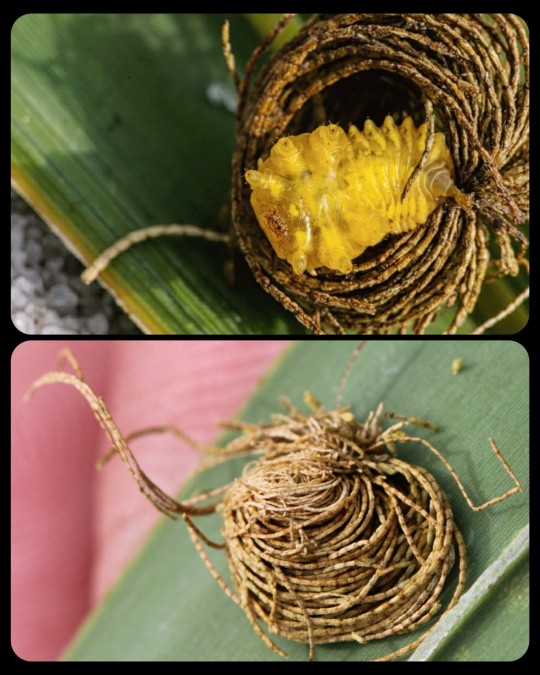
During its larval stage, the Palmetto tortoise beetle (Hemisphaerota cyanea) uses its own feces to create a defensive layer known as a "fecal shield" or "fecal thatch."
As this article explains:
Most remarkable, perhaps, is the fecal “thatch” of Hemisphaerota cyanea. In the larva of this beetle, the feces are emitted in strands, which, as they build up over the course of larval life, form a loose assemblage that totally hides the larva from view.
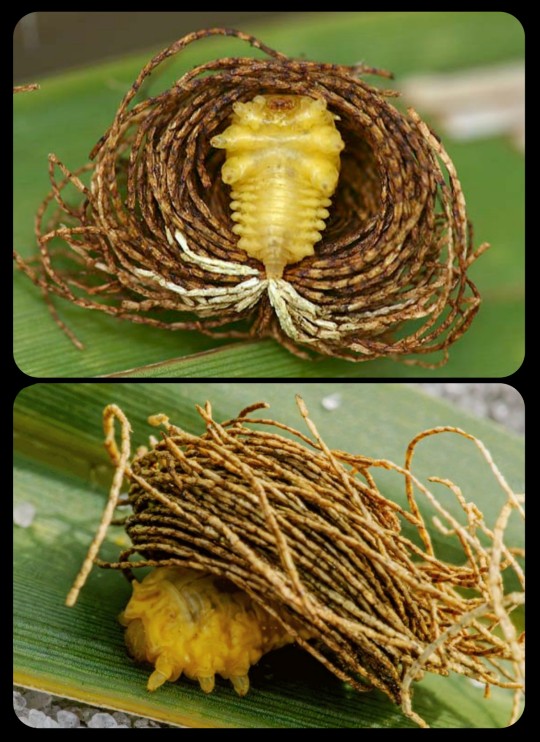
The construction of the "fecal thatch" begins almost immediately after the larva hatches. Each larva begins to feed within minutes of hatching, and the very first fecal strands emerge from its anal turret just a few minutes later. Subsequent strands are then produced in quick succession, and they begin to accumulate around the larva's body; as each strand emerges, it is made to curve around the larva's left or right side depending on whether the anal turret is flexed to the left or right. The direction of the curve usually alternates from one strand to the next, ensuring that a nest-like structure is formed around the larva's body.
As they emerge, the fecal strands are gathered together and then cemented into place with the help of an anatomical feature known as a caudal fork. Once an individual strand has been extruded to its full length, the anal turret is rotated upward until it comes into contact with the caudal fork, and the larva then pinches off the strand while secreting a droplet of "glue," which effectively cements each fecal strand into place against the caudal fork.
It generally takes about 12 hours for the larva to finish building its very own "fecal shield."
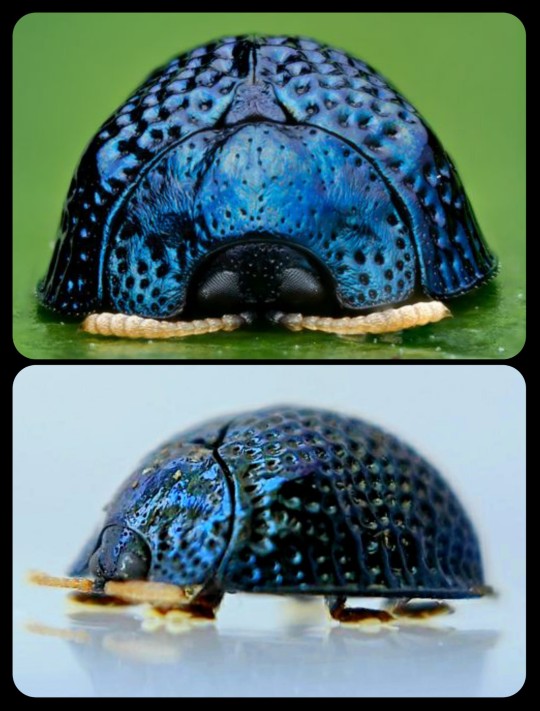
As an adult, the Palmetto tortoise beetle has another unusual defense mechanism: its tarsi (i.e. feet) are each lined with 10,000 tiny adhesive bristles, and when the beetle is attacked, it can press its feet flat against the surface of a leaf and secrete an oil that allows it to adhere to that surface with an enormous amount of strength. The adhesive mechanism is strong enough to resist pulling forces that are up to 60 times greater than the beetle's own weight for a full 2 minutes; it can resist even greater forces (up to 230 times greater than the beetle's own weight) for shorter periods of time.
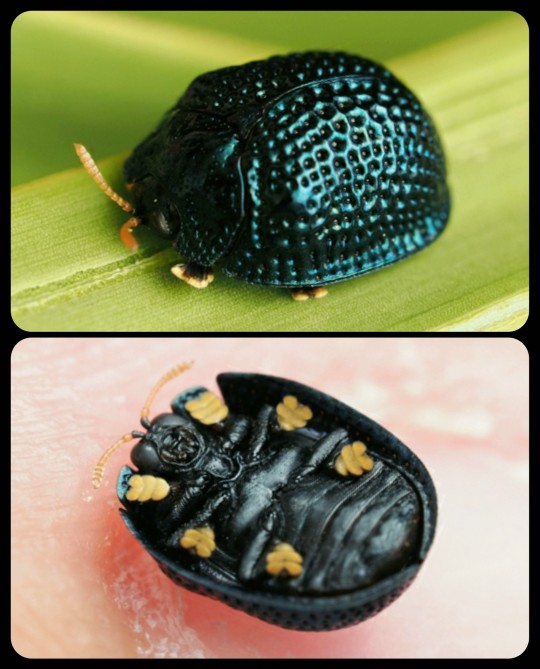
According to this article from the University of Florida:
Each of the greatly enlarged tarsi is equipped with approximately 10,000 adhesive bristles. Each bristle has two terminal pads. When walking, only a few of the bristles touch the leaf surface. However, when attacked by a predator, the beetle puts all or nearly all of the bristles in contact with the surface and secretes oil onto the pads. With the adhesive force created by the oil between the leaf surface and tarsi, the beetle is able to clamp its hemispherical shell down tightly against the leaf and has been demonstrated to withstand pulling forces of approximately 60 times its own weight for up to two minutes. This time period is sufficient to thwart the efforts of predatory ants attempting to pry the beetle from the leaf.
Palmetto tortoise beetles are native to the southeastern United States, and they're especially common in Florida (which is why they're also known as Florida tortoise beetles).
Sources & More Info:
Proceedings of the National Academy of Sciences: Defensive Use of a Fecal Thatch by a Beetle Larva (Hemisphaerota cyanea)
Earth Touch News Network: By the Power of the Poop-Shield: Beetle Defenses of the Faecal Kind
Cornell Chronicle: Fecal Defense: This Beetle Uses 'Overhead Sewer System' to Ward off (most) Predators, Cornell Biologists Discover
Proceedings of the National Academy of Sciences: Defense by Foot Adhesion in a Beetle (Hemisphaerota cyanea)
University of Florida: Palmetto Tortoise Beetle
Bug Guide: Hemisphaerota cyanea
#entomology#arthropods#coleoptera#palmetto tortoise beetle#hemisphaerota cyanea#insects#beetles#bugs#animal facts#tortoise beetles#larvae#fecal shield#evolution#defense mechanisms#nature is weird
126 notes
·
View notes
Text
Uncharismatic Fact of the Day
Do you hate getting water up your nose? The Aldabra giant tortoise doesn't! In fact, this species drinks through their nose; their flat snouts are specially designed to allow them to draw water from shallow pools, which is critical in an environment where water is scarce.

(Image: An Aldabra giant tortoise (Aldabrachelys gigantea) wearing a fashionable hat (Telfair's skink) by Nik Cole)
If you like what I do, consider leaving a tip or buying me a kofi!
243 notes
·
View notes
Text
✨ Star Friends ✨

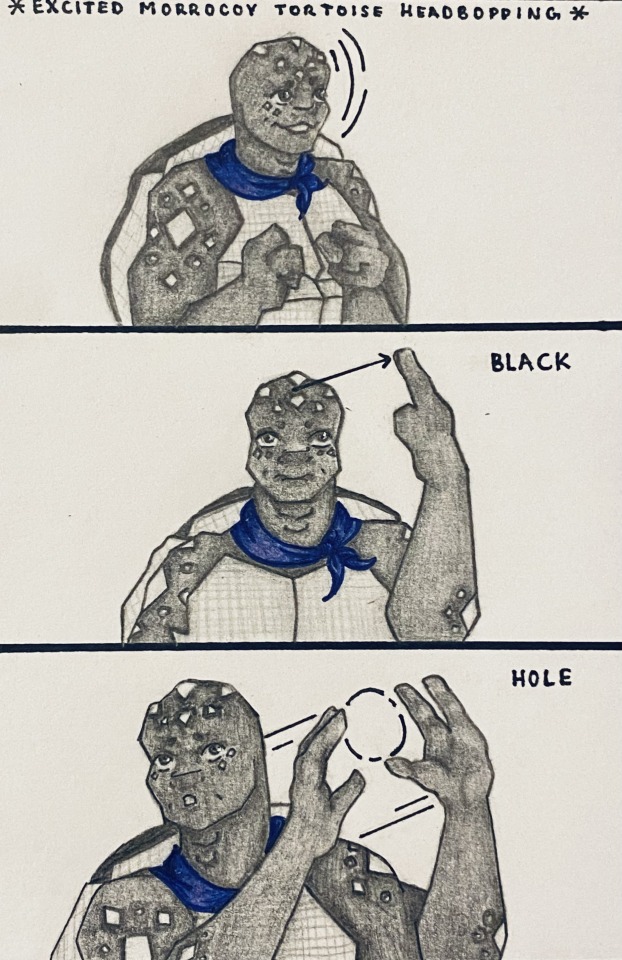
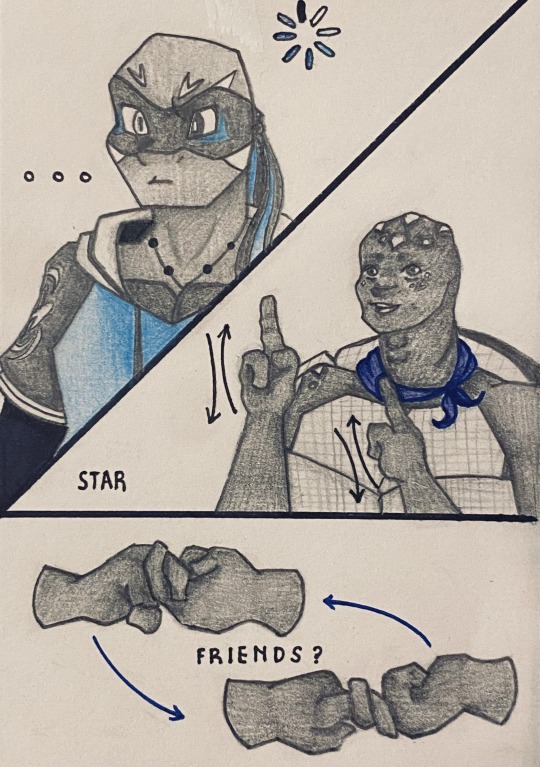

When I found out that @chessman-protocol boy Crit liked Astronomy, let’s just say I was beyond estatic and immediately planned this little comic. Here’s to my boy Vincent doing his best to make friends with folks who share similar interests 😅💙
Funny enough, I didn’t realize I put this in Vincent character’s until I looked at the whole thing, but Vincent very much shares the lack of stranger danger the way I did/ I do to this day. To quote one of my past managers I’m “abnormally friendly” or whatever
I can’t tell you how many times even as a small child (drove my parents nuts) that I saw a cool person with whatever connecting factor and I just straight up walked to them and was like “Ok cool. We’re friends now.” And nobody’s really stopped me? So apparently I have friends now. 😆
Vincent however is just a wholesome baby boy who doesn’t realize he’s actually an intimidating hunk of a turtle and randomly walking up to strangers and not saying anything can be taken the wrong way.
Like I said, he’s trying his best. He wasn’t exactly the most socialized if you can’t tell, but he does love dearly and is certainly a boone of a friend to have once you get past the inevitable social awkwardness. He’s loyal to put because he really doesn’t know better, and I adore him for that. Anyway, dunno if Crit knows any ASL or not, but either way Vincent is just excited to meet somebody else who likes space ✨🌌 💙
#just being jayus#doing this ugly and scared#my boy <3#Vincent my beloved#rottmnt original character#rottmnt oc#original comic#rottmnt#save rottmnt#unpause rise of the tmnt#time to go feral in the comments again; please ignore the ramblings of an insane person#Fun fact: Vincent is mute (late mutation and didn’t fully develop vocal chords) and so he only speaks turtle and partial ASL#Morrocoy Tortoise AKA Yellow or Red Footed Tortoise bop their head to assert dominance and show emotions#Head hopping and headbutting is Vincent’s tic and you can tell how he’s feeling by how fast or slow he goes because it’s a VIBE#Working on this comic was like the preverbal attempt of taking a horse to water#except this horse is a pony (anything under 14 hands is of the devil) and would not even spare it a glance unless it was perfection#Alas mockery and spite is unfortunately my demise and I could not handle the blank page any longer#Can you see how my style changed when the focus and subject changed?😅#Forgive me my son#for I have not learned to draw you from all angles yet.#Why did I make you so pretty and detailed in my head and yet have my hand betray you?!#The true tragedy is when your idea level is not at your skill level bECaUsE I KnOw wHaT hEs SuPpOsEd To LoOk LiKe BuT I CaNt DrAw HiM yEt#So here we are and I am accutely aware of how much work there is to be done. I’m looking at you flippin turtle anatomy#But hey we all have to start somewhere#so here I am#I tried and by golly I will keep trying. Vincent deserves that much 😅🧡🫡#I just looked back at this and realized I MISSED A STINKING PANEL. And Vincent’s shirt.#Flips a table in my mind#Also I’ve never made a mute character before so if anybody has notes especially about ASL PLEASE PLEASE P L E A S E lemme know.#Wanna make sure I represent the peoples correctly 🫡🧡
25 notes
·
View notes
Text
rewatching Elementary for the millionth time and i'd forgotten they find Clyde while investigating a case in s1 🥺
#elementary#xony watches elementary#AGAIN#sherlock is like ofc Im going to eat clyde lmao clyde is going to bury you both and probably arthur too#also in this ep joan says that she won't be with sherlock forever but she did in fact stay forever lmao#the joan watson show#clyde the tortoise
68 notes
·
View notes
Text
Critter fact #131:

The Imperial Tortoise Beetle (Stolas imperialis) is found in the Amazon and Atlantic Forests of Brazil
43 notes
·
View notes
Text








Happy Ice Age Week! Megalochelys is a now extinct genus of giant tortoise which lived throughout what is now Eurasia and Oceania from the Miocene to Pleistocene around 7.2 million to 120,000 years ago. The genus Megalochelys was first named in 1837 by Hugh Falconer and Proby Cautley based on remains found in the Sivalik Hills of northern India which they dubbed species Megalochelys sivalensis, meaning great turtle. However, later in 1844, Falconer and Cautley decided to rename the species Colossochelys atlas as they considered the original name "not to convey a sufficiently expressive idea of the size". During the late 19th century and much of the 20th century, Megalochelys/Colossochelys was considered synonymous with Testudo, and later Geochelone. Colossochelys is now regarded as a junior synonym of Megalochelys, and 4 species are considered valid: Megalochelys atlas, Megalochelys cautleyi, Megalochelys margae, & Megalochelys sondaari. With a possible additional 3 species yet to be formally named. And some authors have argued for the validity of Megalochelys sivalensis. The size of Megalochelys varied considerably between species with the shells of M. sondaari reaching 2.4 to 3ft (70 to 90cms) across, whilst those of the largest species M. atlas got upwards of 6.7ft (2m) across. Meaning that the largest Megalochelys could have gotten up to 9ft (2.7m) long, 6.5ft (2m) tall, and 4,400lbs (2,000kgs) in weight. The shell of Megalochelys is prominently domed, comparatively thin, and is proportionally wide, with large openings for the limbs. The skull had a deep nasal region and short snout. The epiplastron was forked and robust, suggesting they used them in combat similar to there closest extant relative the African spurred tortoise. In life megalochelys would have inhabited jungles, dry forests, grasslands, and scrublands where it fed upon grasses, sedges, fruits, leaves, and carrion.
Art used can be found at the links below
#pleistocene pride#pliestocene pride#pleistocene#pliestocene#ice age#stone age#megalochelys#giant tortoise#colossochelys#turtle#animal facts#prehistoric#extinct#paleontology
8 notes
·
View notes
Text
EVERYBODY SAY THANK YOU SHELBY RIGHT NOW
#after the other finales I was so scared#but this is literally the best thing ever!#She's ACTUALLY the Storm Witch?? From Witchcraft SMP???#Nature Wives is canon in the witch dub!#THE SPIRIT REALM#The Evermoore is all good now!#I can't fucking believe she even tied that one time Bratwurst sent a demon to the Witch Academy#TORTOISE WAS WORKING FOR HER GRANDMA ALL ALONG#She managed to get at least a little portion of the server together for her finale even if it was small#And the fact that she almost became Supreme Witch in wcsmp makes this all even more satisfying#just#I'm gonna cry for the next 16 hours#Empires SMP#Empires season 2#Shubble#Great Witch Shelby
81 notes
·
View notes
Text

Smile like the common snapping turtle (Chelydra serpentina)! This robust reptile, found throughout the eastern and central United States, as well as certain regions of southern Canada, can grow to exceed 70 lbs (31.8 kg) in weight. Its diet includes nearly anything it can catch: Birds, small mammals, fish, and aquatic vegetation are all on the menu. The common snapping turtle is also relatively long- lived, with some individuals surviving for 30 years in the wild—and even longer in captivity.
Photo: billielafond, CC BY 4.0, iNaturalist
#science#nature#natural history#animals#fact of the day#did you know#turtle#tortoise#herpetology#cool animals#snapping turtle#cute animals#smile
739 notes
·
View notes
Text
youtube
youtube
#amber heard#johnny depp is a wife beater#tortoise media#spear campaign#online harassment#bots#astroturfing#abuse#there is curiously little thumbs up for these two videos#for this level of quality and subject#if you can please watch and show your opinion#they say in the video that while they have the material to study many experts did not want to get involved for 'reasons'#it's still going on and the only way to get actual facts out is by promoting it and showing our opinion#this is genuine moment that would help since youtube won't promote#Youtube
9 notes
·
View notes
Text
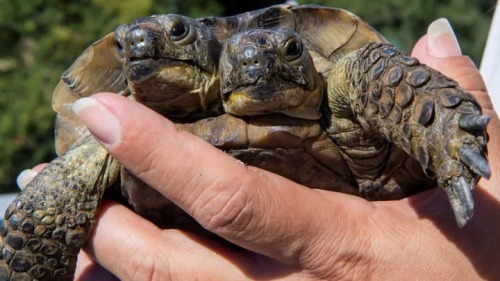
Two-headed tortoise Janus turns 25!
Janus, who also has two hearts, two pairs of lungs and two distinct personalities, would not have survived long in the wild as he cannot retract his heads into his shell to seek shelter from predators. But at the Geneva Natural History Museum, where he hatched in 1997, Bourgoin and her team of carers - who believe he is the world's oldest bicephalic tortoise - can cater for his every need!
He is under constant surveillance in case he flips over, which could be fatal, and survived a bladder stone operation in 2020. His heads need periodic treatment with vaseline to stop them getting sore when they rub together.
His two personalities also generate different moods and tastes that can occasionally lead to conflict, for example over which direction to walk. "The right head is more curious, more awake, it has a much stronger personality. The left head is more passive and loves to eat," Bourgoin said, adding that one head was partial to endives and the other to carrots.
23 notes
·
View notes
Text
Uncharismatic Fact of the Day
What's for breakfast? A pancake tortoise! This species is named for its unusual shell, which is indeed as flat as a pancake. Even more interesting is the fact that, while most other turtles have fairly thick, rigid shells, the pancake tortoise's shell is exceptionally thin, and the underlying bone has openings which allows the shell to be quite light and flexible.
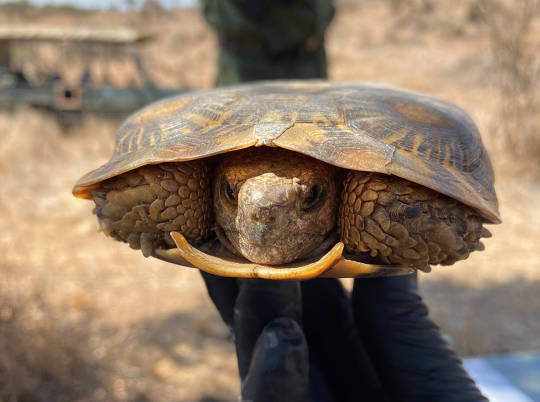
(Image: A researcher holding a pancake tortoise (Malacochersus tornieri) by the Lewa Research Department)
If you like what I do, consider leaving a tip or buying me a kofi!
191 notes
·
View notes
Note
What is a favorite fact that you like but feel like you never have a chance to share? More than one favorite is also totally acceptable.
heyyy :)
thanks so much for the ask! (i haven't forgotten your other ask... i'll just take some more time to answer it properly)
these facts are gonna be mostly silly but well... i am silly sooo...
elephants are actually extremely social. this picture from pinterest where an elephant tries to save a cat just lives in my head rent-free

elephants think humans are cute. like the way we find puppies cute.
you might have heard of the rumor of turtles being able to breathe through their buttholes. well it really depends on what you define as butt and breathe. basically yes, turtles can pump air through their "butts" (technically turtles don't have a butt) and into some organ that is like an aquatic lung. but read more to that here!
all tortoises are turtles but not all turtles are tortoises! (tortoises live at land, turtles live in the water!)
hmmm is that what you expected? probably not but oh well it happened now. yay to elephants and turtles! 🥳
#mo asks#(calling you mo from now on)#turtely answers#asks#random facts#animal facts#elephants#turtles#tortoise#animals
19 notes
·
View notes
Text
Can a tortoise live without its shell? No. Tortoises and turtles are not just inside their shells. They are the shells. The shells are part of their skeletons.
Tortoises and turtles actually come from the same family. In fact, tortoises are turtles. They all come from the family testudines, which are reptiles with a shell that is attached to their ribs. We separate them into turtles that live in the water and tortoises that live on the land, even though they are all air breathing reptiles. Turtles and tortoises have a few other differences as well. Tortoises have a rounder, more domed shell. Turtles have a thinner, streamlined shell. Tortoise shells are harder and turtle shells are softer, with a leathery texture. Tortoises have strong legs that can carry their weight and turtles’ legs are closer to flippers. Tortoises live longer than turtles. The largest tortoise is the giant tortoise and it can live to 120 years. The largest turtle is the leatherback and it can live to about 50 years.
So, what about their shells? Tortoises’ and turtles’ shells are both made of bone. Tortoise shells are made of bone and they have an outer layer of scutes. These are horny plates made of keratin and you can also see them on crocodiles and birds’ feet. They protect the bone of the shell from scratches and impacts, giving it a buffer layer. The also make the color and shape that we know as “tortoise shell”. The top part of the shell is called the carapace and is the big domed section. The bottom part is called the plastron and goes underneath the tortoise, between its legs. The top and bottom parts are joined at the side by bridges. Turtles’ shells are also made of bone, but they don’t have the layer of scutes. The bone in their shells is also less ossified, so it stays softer.
It looks like the tortoises are living inside their shells, but the shells are a part of their skeleton. Their ribs and their spines are fused to the carapace. If you look at the skeleton of a tortoise, the spine runs down the center and the ribs fan out, connecting to the shell on each side. The legs, neck, and tail connect to the spine and are free to move, but the spine and the ribs cannot move. Then, the whole shell is covered in skin. The cutes grow on the outside of the skin to protect everything. Turtles don’t have the scutes, so the top of their shells are covered in skin, which is what gives them the leathery texture. Because both tortoises and turtles are covered in a layer of skin, it means they can feel things touching their shells. Their skin has nerves, just like ours does, so they can feel pressure on the shells.
Most exoskeletons don’t grow and the animals have to shed them and grow a new one each time they get too small. Tortoise and turtle shells are made of bone and they grow with the animal. They are born with their shells and their shells get bigger as they do.
Turtles and tortoises have very strong neck muscles and a very long neck, which is why they are able to move their heads so far and pull their heads back into their shells. They need this because they cannot move their spines and their plastron extends out underneath their heads. If they had shorter necks, they wouldn’t be able to eat.
Tortoises and turtles have strong shells and they look pretty secure, but there are still animals that prey on them. Turtles can be eaten by sharks and other large fish. A Great White Shark and a Tiger Shark can easily bite through a turtle shell. Smaller sharks can’t bite through the shell, so they attack the bits of the turtle that stick out. Tortoises are preyed upon by animals like coyotes and raccoons. They can’t crack the shells, but they can get to the tortoises even when they are hiding. Some large birds of prey, like the Golden Eagle, pick up the tortoises and drop them from a great height, coming down to eat them after their shells have broken. Also, chimpanzees eat tortoises. They pick them up and bang them against tree trunks until their shells break.
So, a tortoise and a turtle cannot live without their shell because their shell is a part of their skeleton and not something they live in. Trying to remove a tortoise from a shell would be the same as pulling you out of your bones. And this is what I learned today.
Read this and 600 other interesting articles on my blog: https://ilearnedthistoday.com/index.php/2023/05/12/can-a-tortoise-live-without-its-shell/
Photo by Pixabay: https://www.pexels.com/photo/black-tortoise-standing-162307/
#tortoise#turtle#shell#scute#tortoiseshell#turtleshell#learn#ilearnedthistoday#learnsomethingnew#learnsomethingeveryday#interestingfact#ididntknowthat#facts#factsdaily#find out#interesting#learning#learnsomethingneweveryday
35 notes
·
View notes